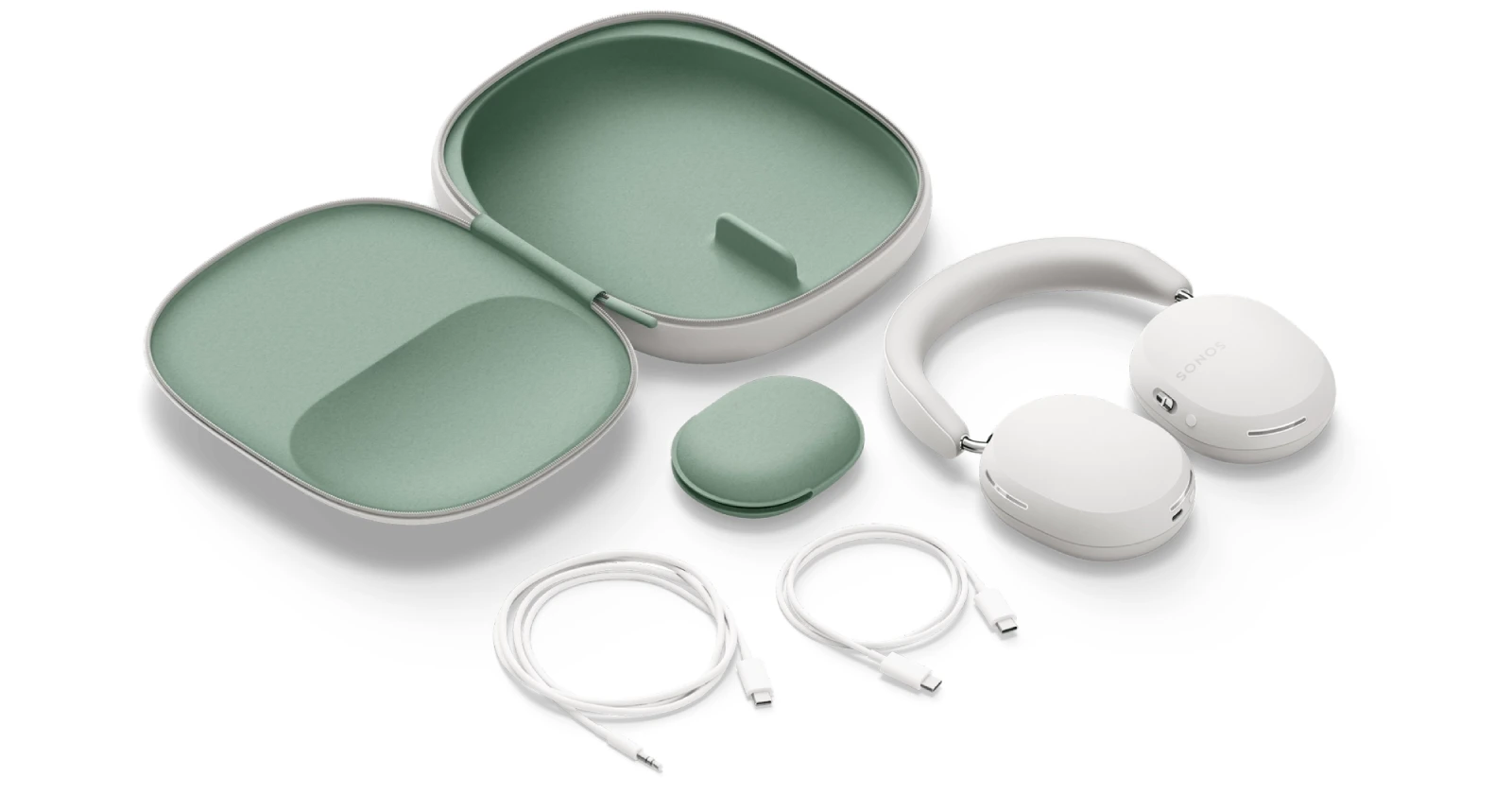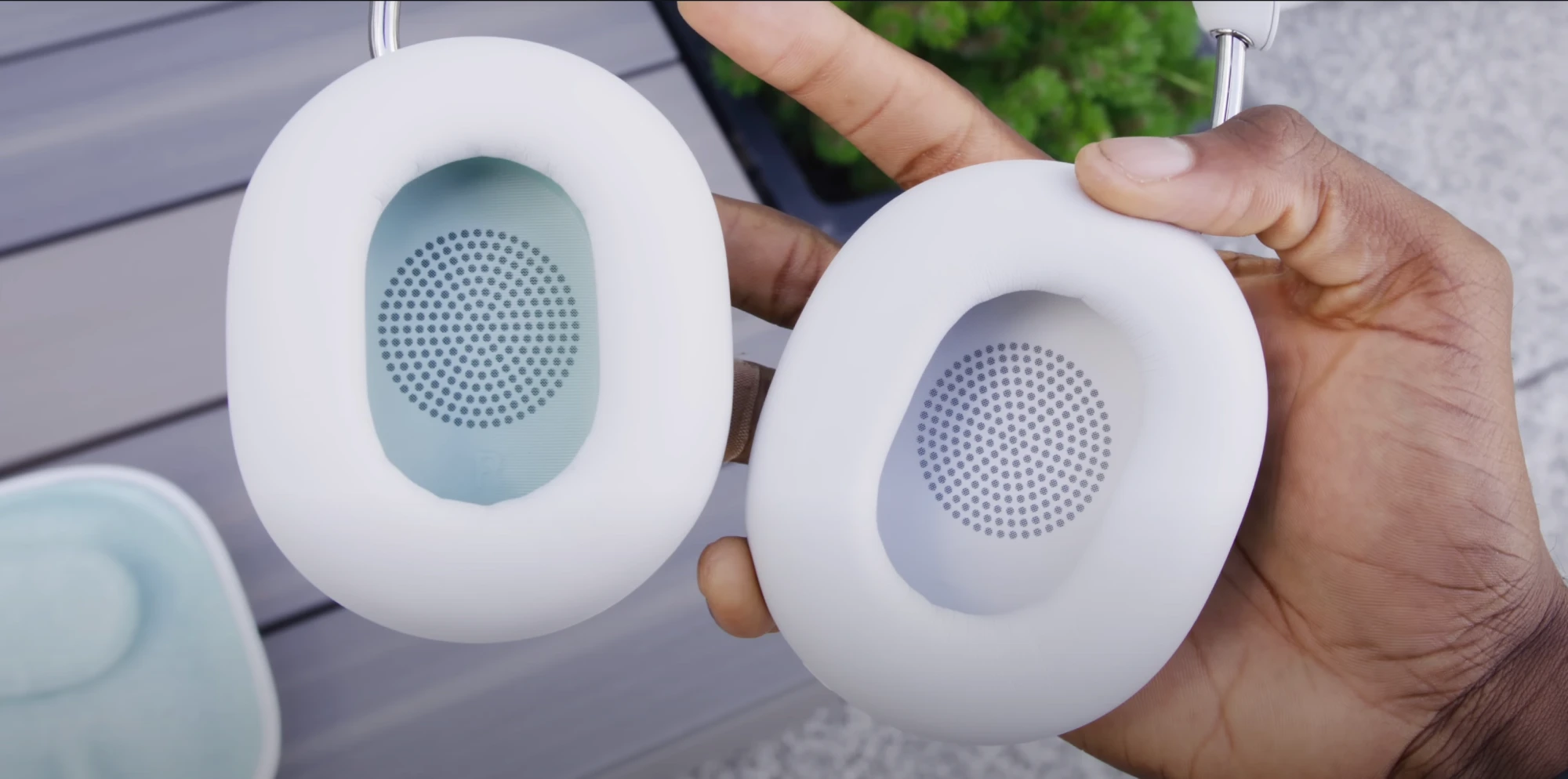Sonos, the titans of home audio, have dipped their toes into the headphone market with the Sonos Ace. But are they a worthy contender against established giants like Sony and Bose? To save you from wading through countless reviews, I’ve compiled insights from major publications (including The Independent, CNET, and Digital Trends) and popular YouTube channels like Smart Home Sounds, The Verge, and MKBHD. This comprehensive analysis will equip you with all the information you need to decide if the Sonos Ace sings your tune.
Design: Sleek but size matters
The Sonos Ace boasts a minimalist aesthetic, with a blend of plastic and stainless steel that reviewers at CNET found both stylish and sturdy. The design aims for a balance between durability and elegance, with the stainless steel headband providing structural integrity and a premium feel, while the high-quality plastic components keep the weight manageable.
YouTubers like MKBHD complimented the comfortable headband and plush ear cups, mirroring the observations of publications like The Independent and many others. The ear cups feature a soft-touch material that feels luxurious against the skin, contributing to the overall comfort. However, some reviewers, including those at What Hi-Fi?, noted that the ear cups might be a tight fit for users with larger ears. This could lead to discomfort during extended listening sessions.
Additionally, Smart Home Sounds did mention that the black variant of the headphones is more prone to showing fingerprint in comparison to the white option. So if you aren’t willing to wipe down your headphones regularly, you might want to consider picking the white color variant.
One standout design feature is the removable magnetic ear cups. This innovation not only makes cleaning and maintenance easier, but also allows for customization. The touch of color to differentiate between the left and right ear cups is also seen by most reviewers as an added bonus. Here’s a still frame from MKBHD’s review for reference:
Comfort: Hits the right notes (for most)
Comfort is subjective, but the general consensus leans towards the Sonos Ace being a comfortable pair of headphones. Reviewers at Digital Trends wore them for hours without experiencing pressure points, even while wearing glasses. The headband is adjustable, allowing users to find a fit that distributes weight evenly across the head, minimizing fatigue during prolonged use.
The Verge and many others echoed this sentiment, praising the soft ear cups and well-padded headband. The memory foam ear cushions conform to the shape of the ears, providing a snug yet comfortable fit that enhances the passive noise isolation. However, as mentioned earlier, some reviewers with larger ears found the fit to be snug, potentially causing fatigue over time.
The clamping force of the headphones is another factor contributing to comfort. The Sonos Ace strikes a balance, providing enough pressure to stay securely in place without being overly tight. This makes them suitable for various activities, from casual listening at home to more active use on the go.
Sound quality: A Sonos signature with a caveat
Sonos is renowned for its immersive sound experience, and the Ace lives up to that reputation (mostly). Reviewers across the board lauded the headphones’ rich, balanced sound with a focus on clear mids and highs. Publications like What Hi-Fi? commended the accurate reproduction of instruments and vocals.
MKBHD highlighted the clarity and depth of the sound but noted a slight bass emphasis that might be overwhelming for audiophiles seeking a perfectly neutral sound signature. In their video, Smart Home Sounds even asked for feedback from a professional Dolby Audio mixer and they too brought up the issue with the bass being a bit overpowering. This bass emphasis provides a punchy, engaging listening experience that suits genres like pop, hip-hop, and electronic music. However, those preferring a more analytical or flat sound profile might find it less appealing.
The Sonos app offers an EQ to tweak the sound profile to your preference. This customization feature allows users to adjust the bass, midrange, and treble frequencies to match their personal taste or the requirements of different music genres. The app also includes various preset sound profiles tailored to specific activities, such as commuting, working out, or relaxing at home.
However, the app still lacks granular control and due to the recent revamp, you might experience various bugs and issues that ruin the overall user experience.
Noise Cancellation: A strong showing, but not class-leading
The Sonos Ace packs a punch when it comes to Active Noise Cancellation (ANC). Reviewers at CNET compared it favorably to established players like Bose and Sony, achieving a noise reduction of around 85% to 90%. This level of noise cancellation is effective at blocking out common ambient sounds, such as the hum of an air conditioner, the roar of airplane engines, or the chatter in a busy cafe.
MKBHD was impressed with the ANC performance and rated the Sonos Ace as “A+” in that regard. Publications like What Hi-Fi? found that the Sony WH-1000XM5 and the Bose QuietComfort Ultra headphone offered slightly superior noise-canceling capabilities.
The ANC performance of the Sonos Ace is bolstered by advanced algorithms that adapt to the surrounding environment, ensuring consistent noise reduction regardless of the setting. This adaptive technology adjusts the level of noise cancellation in real-time, responding to changes in ambient noise levels to maintain an optimal listening experience.
Aside from ANC performance, in ShortCircuit’s review, the host highlighted the subtle effect that you hear when ANC is enabled, rather than a loud voice stating something like “active noise cancellation on,” which can be annoying at times.
Transparency mode: A breath of fresh air
The transparency mode on the Sonos Ace lets you hear your surroundings without removing the headphones. This feature is particularly useful for situations where you need to be aware of your environment, such as walking in busy areas, listening for announcements at an airport, or having quick conversations without taking off your headphones.
Reviewers at Digital Trends praised its natural-sounding quality, allowing for clear conversations without feeling artificial. The transparency mode uses external microphones to capture ambient sounds and play them through the headphones, creating a seamless blend of music and environmental noise. This ensures that you stay aware of your surroundings without compromising on audio quality.
YouTubers at The Verge concurred, finding it on par with the transparency mode offered by Apple’s AirPods Max. Even MKBHD mentioned “they have some of the best transparency mode in anything I’ve heard that’s not AirPods.” The intuitive control scheme makes it easy to switch between ANC and transparency mode with a simple touch or button press, providing flexibility based on your immediate needs.
Most other review articles and videos on the Sonos Ace also share the same thoughts. So if Transparency mode is something you use often, these headphones won’t let you down.
Special features: A mixed bag
The Sonos Ace boasts some intriguing features, but their execution seems to be a work in progress. One such feature is head-tracking spatial audio, which adjusts the sound stage based on your head movements. This technology aims to create a more immersive listening experience by simulating the effect of sound coming from fixed points in space, enhancing the realism of audio content.
The Guardian, and a few others, found it to be a neat addition, especially when paired with Dolby Atmos content. The spatial audio feature works particularly well with movies and certain music tracks, providing a cinema-like experience that places sound effects and instruments around the listener. However, some reviewers, including those at The Verge, felt it wasn’t as polished as similar features offered by competitors. The head-tracking can occasionally be inconsistent, leading to slight discrepancies in the audio positioning. Furthermore, getting TV Audio Swap (which you can use to enjoy spatial audio and head tracking) to work proved to be a pain for some. As Chris Welch from The Verge puts it: “right now, I can take or leave the dynamic head tracking.” So it’s clearly not something that should make or break your decision to purchase the Sonos Ace.
Speaking of TV Audio Swap, this feature lets you seamlessly switch the audio source from your Sonos speaker system to the headphones. This is particularly convenient for late-night movie marathons or when you want to enjoy TV audio without disturbing others. As mentioned above, multiple reviewers, including those from CNET, found it to be a convenient solution, but noted occasional connection hiccups. The feature relies on a stable wireless connection to ensure smooth transitions between audio sources, and any interference or signal drop can affect performance.
The Sonos Ace also includes voice assistant integration, compatible with both Amazon Alexa and Google Assistant. This allows for hands-free control of music playback, volume adjustments, and other functions through simple voice commands. The built-in microphones are designed to pick up voice commands clearly, even in noisy environments, making it easy to interact with your digital assistant without having to reach for your phone or other devices.
Battery life and charging: Lasting power
Battery life is a critical factor for wireless headphones, and the Sonos Ace delivers a respectable performance in this area. The headphones offer up to 20 hours of playback time with ANC enabled, which is competitive with other high-end models on the market. Reviewers at Digital Trends noted that the battery life is sufficient for a full day of use, whether for work, travel, or leisure.
When it comes to charging, the Sonos Ace features a USB-C port, ensuring fast and convenient recharging. A quick 15-minute charge provides around 3 hours of playback, which is handy for those moments when you need a quick power boost before heading out. The headphones also support wireless charging with compatible Qi chargers, adding an extra layer of convenience for users who prefer a cable-free experience.
Connectivity: Seamless integration and stability
The Sonos Ace supports Bluetooth 5.0, providing a stable and efficient wireless connection with minimal latency. This ensures that audio and video remain synchronized during media playback, enhancing the overall user experience. The headphones also feature multi-point connectivity, allowing them to connect to two devices simultaneously. This is particularly useful for users who frequently switch between their phone and computer, enabling seamless transitions without the need for manual re-pairing.
The integration with the Sonos ecosystem is another highlight. For existing Sonos users, the Ace can seamlessly integrate with their home audio setup, allowing for synchronized playback across multiple devices. This feature leverages Sonos’ proprietary wireless technology to ensure smooth and consistent audio performance throughout the home. The Sonos app further enhances connectivity by providing easy access to various settings and features, such as EQ adjustments, ANC controls, and firmware updates.
However, reviewers at Sound Guys claimed “The connection range between the Sonos Arc and Sonos Ace seems to be quite limited.” Furthermore, the lack of true Wi-Fi connectivity features is another downside, as pointed out by PCMag. Overall, not many reviewers had much to say about the connectivity aspect of the headphones. So it’s safe to assume that the Ace is neither bad nor the best when it comes to connectivity.
Build quality and durability: Built to last
The Sonos Ace is built with high-quality materials that convey a sense of durability and premium craftsmanship. The combination of stainless steel, high-grade plastics, and soft-touch materials not only enhances the aesthetic appeal but also contributes to the overall robustness of the headphones.
Reviewers at The Independent and What Hi-Fi?, amongst others, noted that the build quality feels solid, with no creaking or flexing even under moderate pressure. The headband is reinforced with metal components to prevent breakage and ensure long-term durability, while the ear cups and hinges are designed to withstand regular use without showing signs of wear.
The removable magnetic ear cups add to the durability by making it easy to replace worn-out cushions without needing to buy a new pair of headphones. This not only extends the lifespan of the product but also allows users to maintain the headphones in optimal condition with minimal effort.
But there’s one downside here as I spotted in Smart Home Sounds’ review. The Sonos Ace headphones don’t have an IP rating, meaning, you might end up ruining your premium headphones if you accidentally expose them to liquids. However, the reviewer did confirm that they used the headphones to workout and during their runs without much trouble. Wiping down the ear cups immediately after, however, is recommended.
Price: A premium pair with a premium price tag
The Sonos Ace carries a hefty price tag of $450. This positions it firmly in the premium segment of the market, competing with flagship models from brands like Sony, Bose, and Apple. Reviewers at The Independent found this to be a sticking point, especially considering some of the minor drawbacks.
MKBHD and other reviewers acknowledged the high price but pointed out the excellent transparency mode, build quality, and even the fact that it’s perfect for those who want to switch between using their Sonos speakers and the headphones seamlessly. The inclusion of advanced features like head-tracking spatial audio, TV Audio Swap, and high-quality materials does add value, but potential buyers should weigh these against their specific needs and budget. Overall, I found that most reviewers find the price of the Sonos Ace to the biggest flaw.
The noise issue
Our recent coverage highlighted a potential noise issue with the Sonos Ace. Some users have reported a faint hissing sound, particularly when ANC is active. This noise is subtle but can be noticeable in quieter environments or during low-volume listening. While not all reviewers encountered this problem, it’s worth considering if you have a low tolerance for background noise.
Sonos has acknowledged the feedback and is reportedly working on a firmware update to address the issue. Since there’s no ETA for a fix, it can be a major issue if you’re going to rely on ANC.
The verdict: A strong debut, but room for improvement
The Sonos Ace is a solid first attempt by Sonos in the headphone market. It boasts excellent sound quality, effective noise cancellation, and a comfortable (for most) design. The inclusion of innovative features like removable magnetic ear cups, head-tracking spatial audio, and seamless integration with the Sonos ecosystem adds to its appeal.
However, the slightly boomy bass, potential fit issues for larger ears, and the occasional presence of a faint hissing noise with ANC could be dealbreakers for some users. The price tag also sits firmly in the premium category, making it a tough sell for casual listeners.
Here’s the breakdown:
Pros:
- Excellent sound quality
- Effective noise cancellation
- Comfortable design (for most ears)
- Seamless integration with Sonos ecosystem (if applicable)
- Innovative features like removable magnetic ear cups and head-tracking spatial audio
- Reliable connectivity and multi-point support
- Solid build quality and durability
Cons:
- Slightly boomy bass
- Potential fit issues for larger ears
- Occasional hissing noise with ANC
- High price point
Ultimately, the decision comes down to your priorities. If you’re a Sonos enthusiast seeking superb sound and ANC for your home audio setup, the Sonos Ace could be a compelling choice. However, if perfect fit, absolute silence, or a more neutral sound profile is paramount, you might be better served looking elsewhere, especially considering the hefty price tag. For those willing to invest in a premium product with unique features and excellent integration with the Sonos ecosystem, the Ace offers a distinctive and satisfying listening experience.






